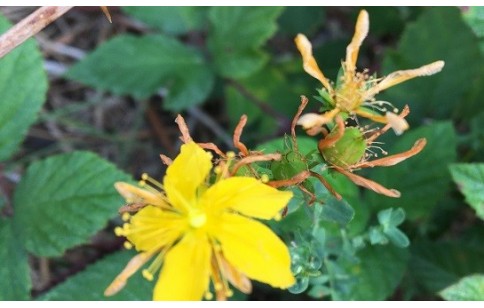- Code : #1057 S 10 mg
- Formula : C₃₀H₁₈O₁₀
- CAS : 1617-53-4
Hypericum perforatum
Hypericum perforatum, “St John’s wort” in English and “Millepertuis perforé” in French (“millepertuis” meaning “a thousand holes”), belongs to the Hypericaceae botanical family. It is a herb with stems that can reach a height of 1 m.
St John’s wort, native to Europe and Western Asia, now grows in most temperate zones of the world. It thrives in prairies and pastures and is considered as a weed in many countries.
It is used as a medicine for milder form of neurotic depression. In folk medicine, it is employed against diarrhea, as a diuretic, against bed-wetting, rheumatism and gout. Mixed with oil in the form of Oleum hyperici, it is used for healing wounds and for burns.
Its main constituents are hypericin and hypericin-like substances; flavonoids, particularly hyperoside and rutin as well as biflavones (amentoflavone), hyperforin, essential oil and up to more than 10% tannins.

- Code : #1411 S 10 mg
- Formula : C₂₁H₂₂O₁₁
- CAS : 29838-67-3
- Code : #4991 S 50 mg
- Formula : C₁₆H₁₈O₉
- CAS : 327-97-9
- Code : #0977 S 20 mg
- Formula : C₁₅H₁₄O₆
- CAS : 490-46-0
- Code : #0468 S 10 mg
- Formula : C₃₀H₁₆O₈
- CAS : 548-04-9
- Code : #1027 S 20 mg
- Formula : C₂₁H₂₀O₁₂
- CAS : 482-36-0
- Code : #0493 10 mg
- Formula : C₃₀H₁₈O₈
- CAS : 548-03-8
- Code : #1135 S 20 mg
- Formula : C₁₅H₁₀O₇,2H₂O
- CAS : 6151-25-3
- Code : #1418 S 10 mg
- Formula : C₂₁H₁₈O₁₃
- CAS : 22688-79-5
- Code : #1139 S 50 mg
- Formula : C₂₇H₃₀O₁₆
- CAS : 153-18-4











